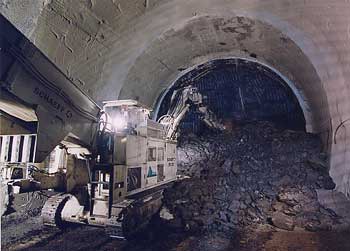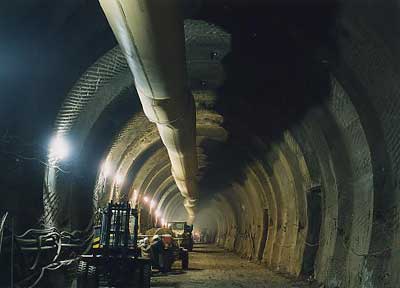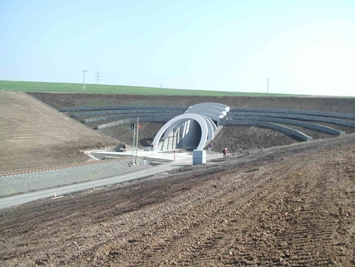Březno Railway Tunnel - Pre-Lining Support Method
 ORDERING PARTY:
ORDERING PARTY:
České dráhy, s.o.
Transportation Routes Division
Prague
Transportation Routes Division
Prague
FINANCING ORGANIZATION:
Severočeské doly, a.s
Chomutov
Chomutov
DESIGNER:
SUDOP Prague a. s.
CONTRACTOR:
ASSOCIATION OF SUPPLIERS
Metrostav a.s.
SSaŽ a.s
Metrostav a.s.
SSaŽ a.s
TUNNEL CONSTRUCTION IMPLEMENTATION:
Metrostav a.s.
Koželužská 2246
180 00 Prague 8
Koželužská 2246
180 00 Prague 8
CONSTRUCTION PERIOD:
05/2000 - 04/2007Commencement of commissioning: 1.4.2007
TECHNICAL DATA:
Brown coal extraction at the Libouš open cast mine in Northern Bohemia brought about the need for the relocation of the rail track section between Březno u Chomutova - Chomutov, which was part of the Prague – Chomutov rail line. The relocated stretch of the rail line is 7.1km long; it comprises the 1758m long, single-rail Březno tunnel (with the mined section 1478m long). The tunnel is the longest rail tunnel on the Czech Railways’ network.The owner chose a mechanical pre-cutting method (MPM) to be used for the excavation and installation of the primary lining. This method was assumed to be well suited to the existing geotechnical conditions, i.e. unstable and squeezing ground, low-strength clayey rock and relatively shallow overburden. The excavation passed through fine grained, medium plastic to fat clays and black chalk, with transitions to claystone. In addition, according to prognoses, there were remnants of undocumented mining activities likely to be encountered in the area. These prognoses were confirmed during the excavation in a much larger extent than expected. A coal seam dipping in the direction of the excavation under the tunnel bottom was encountered at the Březno portal, where the excavation started.
The above-mentioned facts necessitated an additional survey, filling of abandoned mine workings within the required extent, installation of additional anchors for primary support and a new assessment of the final lining of the tunnel, which has the character of a longitudinally acting beam.
The cutting for pre-vaults was carried out by a Perforex 3713 (the training of contractor’s crews was provided by BEC Freres S.A., a French company). A PG – 115 drilling set drilled boreholes for 16m long GRP anchors. Pre-vaults, which were created by the filling of the cut slots with shotcrete, formed 5m long and 200mm thick, splayed arches ahead of the tunnel. The pre-vaults were allowed to overlap each other by 0.5 to 2.5m. The rock breaking at the face and muck loading was performed by a Schaeff 312 excavator.
The excavation of the initial 308m long stretch was made more difficult due to the abandoned mine workings encountered, which had to be filled. The construction of pre-vault segments was also very difficult. In addition, the stability of the primary lining had to be improved by means of radial anchors and bracing concrete sills. An invert was installed under 11 pre-vaults.
In the second stretch, which was 370m long and ended at chainage km 1.920, the excavation encountered the geotechnical conditions which had been anticipated by the survey; it progressed satisfactorily, with monthly advance rates of nearly 100m.
The excavation of the next stretch, beyond chainage km 1.920, had to cope with very unfavourable and unexpected geotechnical conditions (weathered and fractured, only stiff consistency claystone). A series of measures was adopted to stop the increase in deformations (radial anchors, closing of the profile, bracing of pre-vaults). Despite all measures, the tunnel collapsed at chainage 2.082, along a length of about 85m, on 5.5.2003. The pre-vault machine was also buried by the collapse.
The tunnel excavation was eventually finished by counter-heading from the other portal, using the sequential method (SEM). The recovery of the collapsed tunnel and the pre-vault machine required extraordinary measures (for more detail see Tunel issue No. 4/2007). The fact that no injury was suffered during the collapse event or during the recovery operations is a great positive.
At the beginning, the final (secondary) lining was erected concurrently with the excavation, with a lag behind the excavation face over 400m. The concrete invert was cast under a steel bridge structure, which allowed access to the face; it was moved ahead along with the excavation face proceeding. Then the installation of the waterproofing system and casting of the upper vault followed.
The rail line was opened to traffic on 1.4.2007.
Basic data:
|
Net cross sectional area of the tunnel |
43.7 m2 |
|
Theoretical excavated area at the MPM |
63.8 m2 |
|
Length of the MPM driven part |
864 m |
|
Longitudinal gradient of the alignment |
0.8 - 1.0 % |



